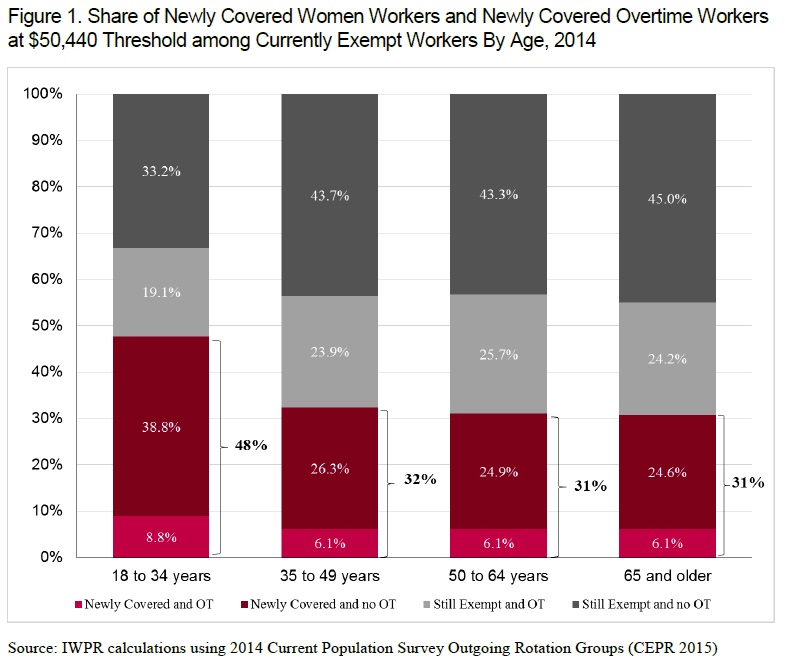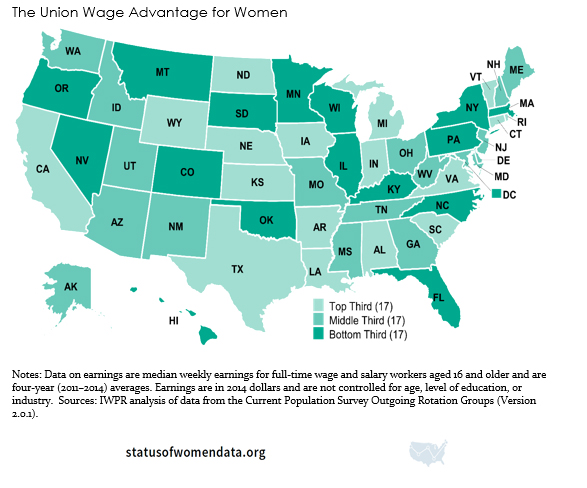By Rachel Eichhorn and Rachel Linn
What a year it’s been for the Institute for Women’s Policy Research! In 2015, we released 119 publications, including the seven chapter Status of Women in the States: 2015 report, with an accompanying interactive website. IWPR research was cited more than 2,100 times in media outlets around the country – from a feature in Glamour Magazine to a skit on Comedy Central’s Inside Amy Schumer. Our staff also presented or participated in over 60 meetings and events on key issues affecting women and families.
Below are our top 5 findings of 2015 (plus a bonus!) from our many research reports. Let us know which one you found most interesting or surprising on Twitter or Facebook using #IWPRtop5.

This Spring, IWPR released the highly anticipated Status of Women in the States: 2015 report, ranking and grading the status of women on six topic areas: Political Participation, Employment & Earnings, Work & Family, Poverty & Opportunity, Reproductive Rights, Health & Well-Being, plus data on Violence & Safety.
The site is also the most accessible, comprehensive source of state data on women of color in the U.S. Browse spotlight pages that highlight data on specific groups, such as older women, Millennials, women living in same-sex households, immigrant women, and women in unions.

A viral segment on The Daily Show called “The Future of Gender Wage Equality” summarized this finding perfectly when Kristen Schaal explained how humans will go to Mars before women get pay equity!
3. Women will not achieve political parity in Congress until the year 2117.

In 2015, 20 of 100 members of the U.S. Senate (20 percent) and 84 of 435 members of the U.S. House of Representatives (19.3 percent) are women. These numbers represent an increase since 2004, but the number of seats held by women in the U.S. Congress is still well below women’s share of the overall population.
4. Nearly half of current exempt Millennial women will gain overtime coverage under new U.S. DOL rule.

In a report co-authored by MomsRising, IWPR found that working women—especially young women, single mothers, women workers of color, and women working in service and administrative support positions—have the most to gain from an increase of the overtime salary threshold to $50,440 proposed by the U.S. Department of Labor in July 2015. The collaboration with MomsRising helped to put a human face on those that would be positively affected by the rule change.
5. Women experience higher poverty rates than men for every demographic group and at all ages.

The report, Toward Our Children’s Keeper, provides a discussion and analysis of the interim report of President Obama’s My Brother’s Keeper initiative, using data for males and females together as a reference point. The report argues that initiatives addressing the needs of young people of color should address the needs of girls and young women of color, as well as those of boys and young men of color, rather than targeting separate spending and program initiatives solely at boys and young men of color.
BONUS!
 This summer, IWPR released a briefing paper that converted women’s union advantage into childcare costs. Women represented by a union in the United States earn an average of $212 more per week than women in nonunion jobs. Union women earn more in every state, with the size of the union wage advantage varying across states: union women in Wyoming earn $349 per week more than their nonunion counterparts, while union women in the District of Columbia earn $48 more per week than D.C.’s nonunion women. This union wage advantage for women is sufficient to cover at least the weekly cost of full-time child care in a center for an infant.
This summer, IWPR released a briefing paper that converted women’s union advantage into childcare costs. Women represented by a union in the United States earn an average of $212 more per week than women in nonunion jobs. Union women earn more in every state, with the size of the union wage advantage varying across states: union women in Wyoming earn $349 per week more than their nonunion counterparts, while union women in the District of Columbia earn $48 more per week than D.C.’s nonunion women. This union wage advantage for women is sufficient to cover at least the weekly cost of full-time child care in a center for an infant.
You still have a chance to make research count for women in 2015. Click here to make a tax-deductible donation to IWPR.


